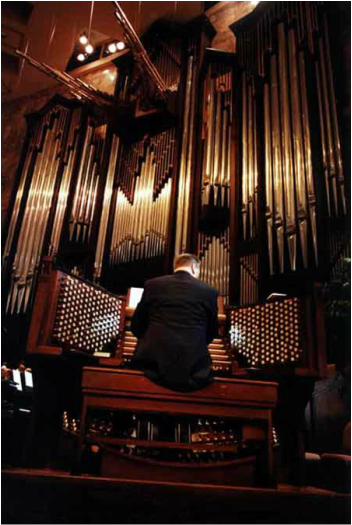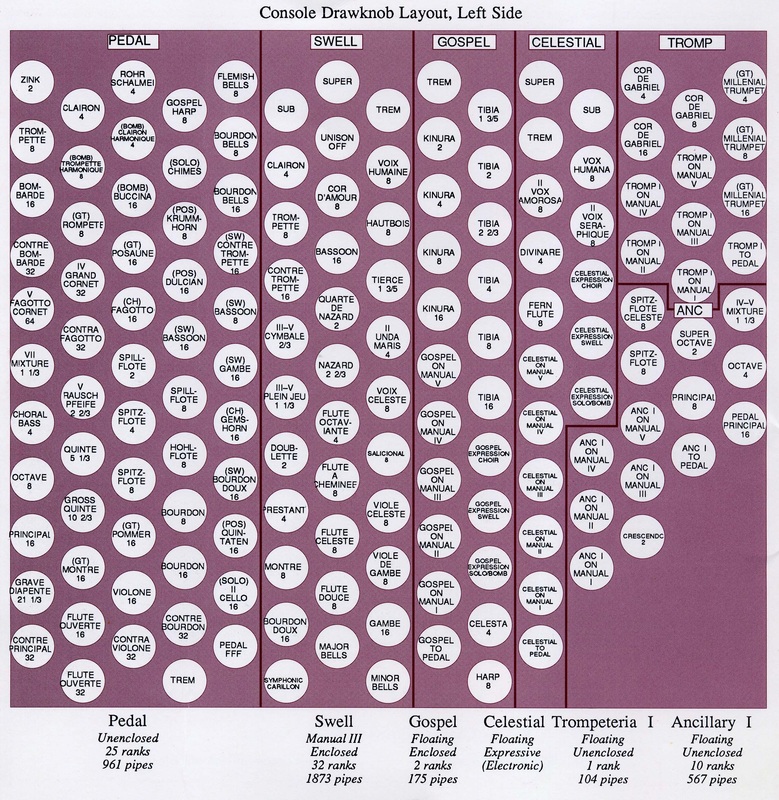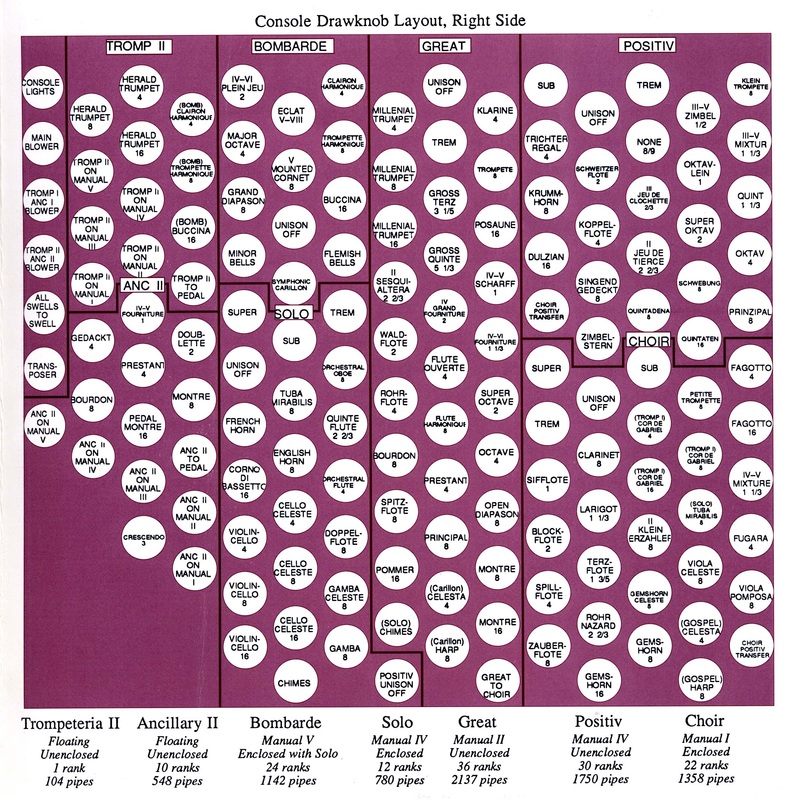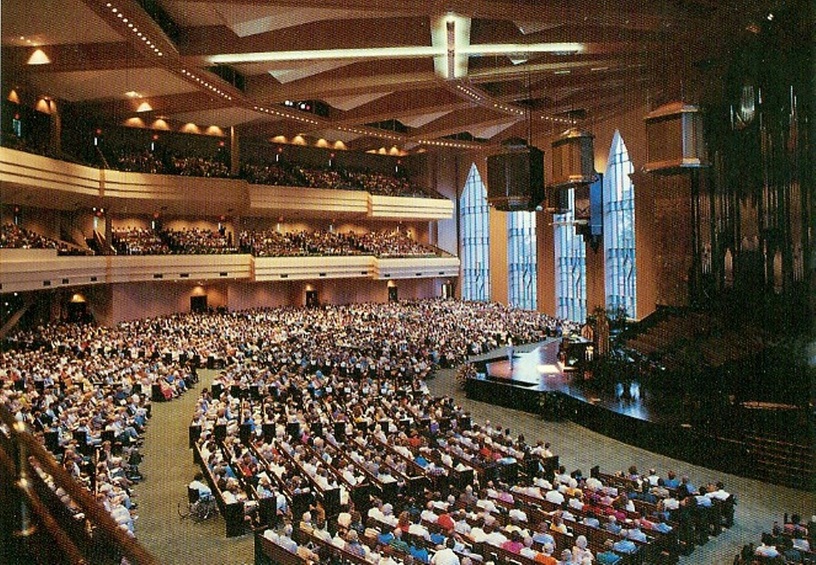About the Calvary Grand Organ
Calvary Church, Charlotte, North Carolina
5 Manuals
205 Ranks
11,499 pipes
Built by M.P. Möller, 1986 - 1990
The magnificent pipe organ of Calvary Church is internationally renown as one of “the” organs in history. Built in 1986—1990 by the M.P. Möller Company of Hagerstown, Maryland USA, the Calvary Grand Organ is the thirteenth largest playable organ in the world, and has a replacement value of well over 3 million dollars.
The purpose and mission of the Calvary Grand Organ is to aid in providing a true worship experience and to help proclaim the message of salvation to all who see, hear, and play it – that the commandment of the scripture will be fulfilled: “Praise Him … with the organ.”
Carefully planned and designed for the congregation of Calvary Church, the 205 rank organ has 11,499 pipes ranging in size from 40 feet tall to hundreds of tiny pipes smaller than soda straws. Why is the organ so large? First of all, because of the spacious 5,500-seat sanctuary with 2.5 million cubic feet of airspace and excellent acoustics of a reverberation time just less than 3 seconds. Secondly, to fulfill the organ’s multiple ministries: to support strong congregational singing; to sensitively accompany choir and vocalists; to provide a spiritual environment for worship, prayer, communion, commitment; to meet the varied demands of Calvary’s diverse musical styles and literature – from 5th century hymns to Bach and Beethoven to southern gospel to contemporary Christian music; to provide festive music to celebrate weddings and other occasions. By meeting all these needs, the organ automatically becomes a grand concert instrument that can play virtually any composition ever written for the organ.
To command all the resources of this instrument requires the massive console – five keyboards (manuals) and pedalboard, 306 wooden drawknobs, and around 200 other controls. To the layman, the magnitude of the organ console may resemble the cockpit of an airplane or space shuttle with the array of stops, buttons, dials, lights, foot pedals, knobs, and switches. The Calvary Grand Organ’s handcrafted Honduras mahogany console is one of the largest American-made drawknob consoles.
This achievement in sound reflects our rich church music heritage, and is a monument of excellence and praise to God: “Let everything that hath breath, praise the Lord!”
205 Ranks
11,499 pipes
Built by M.P. Möller, 1986 - 1990
The magnificent pipe organ of Calvary Church is internationally renown as one of “the” organs in history. Built in 1986—1990 by the M.P. Möller Company of Hagerstown, Maryland USA, the Calvary Grand Organ is the thirteenth largest playable organ in the world, and has a replacement value of well over 3 million dollars.
The purpose and mission of the Calvary Grand Organ is to aid in providing a true worship experience and to help proclaim the message of salvation to all who see, hear, and play it – that the commandment of the scripture will be fulfilled: “Praise Him … with the organ.”
Carefully planned and designed for the congregation of Calvary Church, the 205 rank organ has 11,499 pipes ranging in size from 40 feet tall to hundreds of tiny pipes smaller than soda straws. Why is the organ so large? First of all, because of the spacious 5,500-seat sanctuary with 2.5 million cubic feet of airspace and excellent acoustics of a reverberation time just less than 3 seconds. Secondly, to fulfill the organ’s multiple ministries: to support strong congregational singing; to sensitively accompany choir and vocalists; to provide a spiritual environment for worship, prayer, communion, commitment; to meet the varied demands of Calvary’s diverse musical styles and literature – from 5th century hymns to Bach and Beethoven to southern gospel to contemporary Christian music; to provide festive music to celebrate weddings and other occasions. By meeting all these needs, the organ automatically becomes a grand concert instrument that can play virtually any composition ever written for the organ.
To command all the resources of this instrument requires the massive console – five keyboards (manuals) and pedalboard, 306 wooden drawknobs, and around 200 other controls. To the layman, the magnitude of the organ console may resemble the cockpit of an airplane or space shuttle with the array of stops, buttons, dials, lights, foot pedals, knobs, and switches. The Calvary Grand Organ’s handcrafted Honduras mahogany console is one of the largest American-made drawknob consoles.
This achievement in sound reflects our rich church music heritage, and is a monument of excellence and praise to God: “Let everything that hath breath, praise the Lord!”
Additional Information
Lowest level (behind the choir loft, on both sides of the baptistry area: Pedal
Second level:
Left – Swell
Center – Great
Right – Swell
Third level:
Left – Gospel
Center – Positiv
Right – Choir
Fourth (top) level:
Solo and Bombarde
Layout of the En Chamades:
Left (Trompeteria I) – Cor de Gabriel 16, 8, 4 (104 pipes)
Center (Main Case) – Millennial Trumpet 16, 8, 4 (16’ = 61 pipes, 8’ = 68 pipes, 4’ = 68 pipes)
Right (Trompeteria II) – Herald Trumpet 16, 8, 4 (104 pipes)
Distribution of the 205 total Ranks
Dimensions of the Main Organ: 60’ high, 60’ wide, and 15’ deep.
Total weight of entire organ, excluding concrete, steel framework, and case: 173,000 pounds
Organ was transported to Calvary Church from Möller Organ Company (Hagerstown, Maryland USA) in 18 semi-trailer trucks.
Installation and voicing time: eleven months.
Mahogany casework of Main Organ and Ancillary Organs designed by Möller Organ Company, manufactured by Zepsa Woodworking, Inc., Charlotte, NC
Honduras mahogany console (built by M.P. Möller Inc.) with moveable platform. Weight of console and platform: 1 ton.
- 11,499 total pipes
- 10,176 pipes in the Main Organ case
- 671 pipes in Ancillary I / Trompeteria I (These divisions are in the organ case to the left of the Main Organ case)
- 652 pipes in Ancillary II / Trompeteria II (These divisions are in the organ case to the right of the Main Organ case)
- Pipe materials
- Façade (display) pipes: polished zinc
- En chamade (horizontal) trumpet pipes: polished bronze
- Pipes behind the façade are made of tin, lead, and other metals, in addition to a variety of woods.
- All façade pipes are speaking pipes
- Façade Pipes in the Main Organ case:
- 32’ Contre Principal – the tall, wider pipes in the center of the two outer towers and in the corbels (the two “two-dimensional” towers)
- 32’ Contra Violone – the tall, thinner pipes in the central tower and the thinner tall pipes in each of the outer towers
- 16’ Montre – lower central tower above the baptistry doors
- 8’ Open Diapason – upper central tower
- V Mounted Cornet – central tower, in front of Open Diapason
- Pedal 8’ Octave – smaller pipes in the three lower left-side areas
- Pedal 8’ Hohl Flute – smaller pipes in the three lower right-side areas
- Façade Pipes in the Ancillary I (left) case: Ancillary I Pedal 16’ Principal
- Façade Pipes in the Ancillary II (left) case: Ancillary I Pedal 16’ Montre
Lowest level (behind the choir loft, on both sides of the baptistry area: Pedal
Second level:
Left – Swell
Center – Great
Right – Swell
Third level:
Left – Gospel
Center – Positiv
Right – Choir
Fourth (top) level:
Solo and Bombarde
Layout of the En Chamades:
Left (Trompeteria I) – Cor de Gabriel 16, 8, 4 (104 pipes)
Center (Main Case) – Millennial Trumpet 16, 8, 4 (16’ = 61 pipes, 8’ = 68 pipes, 4’ = 68 pipes)
Right (Trompeteria II) – Herald Trumpet 16, 8, 4 (104 pipes)
Distribution of the 205 total Ranks
- Principals: 28 ranks
- Reeds: 34 ranks
- Flutes: 44 ranks
- Strings: 22 ranks (this includes the unison and celeste ranks)
- Mixtures: 88 ranks (43% of total)
- En Chamades: 5 ranks
Dimensions of the Main Organ: 60’ high, 60’ wide, and 15’ deep.
Total weight of entire organ, excluding concrete, steel framework, and case: 173,000 pounds
Organ was transported to Calvary Church from Möller Organ Company (Hagerstown, Maryland USA) in 18 semi-trailer trucks.
Installation and voicing time: eleven months.
Mahogany casework of Main Organ and Ancillary Organs designed by Möller Organ Company, manufactured by Zepsa Woodworking, Inc., Charlotte, NC
Honduras mahogany console (built by M.P. Möller Inc.) with moveable platform. Weight of console and platform: 1 ton.
Specification
Console specifications:
306 walnut drawknobs with white maple faces
39 white maple tilting tab couplers
137 white maple thumb pistons
53 brass toe studs
8 brass toe levers
3 expression shoes (Choir, Swell, Solo/Bombarde) and one crescendo shoe
5 manuals, each with 61 keys of bone naturals and walnut sharps
Celestial
Gospel
Ancillary I
Trompeteria I
Ancillary II
Trompeteria II
32-key pedalboard with maple naturals and walnut sharps
Electrically adjustable bench with removable backrest
Solid State Logic multiplex system scans all console functions 250 times per second (stops on/off, key attack/release, position of expression shoe, etc.). The signal is sent from the console through a quarter-inch co-axial cable to the pipe chambers.
There are four locations in the chancel stage floor for console connections.
Solid State Logic combination action, with 24 memory levels and three settable crescendo sequences. Tuttis and silencers are settable on every memory level.
A concealed door gives access to the power lockout and the memory lockout.
The power controls are located on four drawknobs that rotate a quarter turn for power on or off.
Adjustable combinations:
Design team:
Dan Miller, Organist
Dr. Frederick Swann, consultant
Dr. Ronald Ellis, President of M.P. Möller
The Design, Tonal, and Engineering Teams of M.P. Möller.
Tonal Director: Daniel Angerstein.
Voicing by Irv Lawless.
Installation done by David Nelms and Diab Rabie of the Mid-Atlantic Organ Company, Charlotte, N.C.; and the installation team of Möller.
The April, 1991 issue of The American Organist (magazine of the American Guild of Organists) features a cover photo and descriptive article about the Calvary Grand Organ. The Calvary Grand Organ was featured in two Diane Bish Joy of Music programs. Video copies are available by contacting The Joy of Music.
306 walnut drawknobs with white maple faces
39 white maple tilting tab couplers
137 white maple thumb pistons
53 brass toe studs
8 brass toe levers
3 expression shoes (Choir, Swell, Solo/Bombarde) and one crescendo shoe
5 manuals, each with 61 keys of bone naturals and walnut sharps
- V (top manual) – Bombarde
- IV – Solo/Positiv
- III – Swell
- II – Great
- I – Choir
Celestial
Gospel
Ancillary I
Trompeteria I
Ancillary II
Trompeteria II
32-key pedalboard with maple naturals and walnut sharps
Electrically adjustable bench with removable backrest
Solid State Logic multiplex system scans all console functions 250 times per second (stops on/off, key attack/release, position of expression shoe, etc.). The signal is sent from the console through a quarter-inch co-axial cable to the pipe chambers.
There are four locations in the chancel stage floor for console connections.
Solid State Logic combination action, with 24 memory levels and three settable crescendo sequences. Tuttis and silencers are settable on every memory level.
A concealed door gives access to the power lockout and the memory lockout.
The power controls are located on four drawknobs that rotate a quarter turn for power on or off.
Adjustable combinations:
- General (controls the entire organ): 1-20 (thumb pistons duplicated by toe studs)
- Positiv: 0-10 (thumb pistons)
- Swell: 0-12 (thumb pistons)
- Choir: 0-10 (thumb pistons)
- Solo: 0-10 (thumb pistons)
- Bombarde: 0-6 (thumb pistons)
- Pedal: 0-12 toe studs (1-6 duplicated by thumb pistons)
- Trompeteria I/Ancillary I: 0-8 (thumb pistons)
- Trompeteria II/Ancillary II: 0-8 (thumb pistons)
- Gospel: 0-4 (thumb pistons)
- Celestial: 0-4 (thumb pistons)
- Couplers: 0, A, B, C, D, E, F (thumb pistons)
- Divisional cancel pistons (“0”) are located in the keyboard jambs.
- Combination set piston is located underneath the Choir manual on the left side.
Design team:
Dan Miller, Organist
Dr. Frederick Swann, consultant
Dr. Ronald Ellis, President of M.P. Möller
The Design, Tonal, and Engineering Teams of M.P. Möller.
Tonal Director: Daniel Angerstein.
Voicing by Irv Lawless.
Installation done by David Nelms and Diab Rabie of the Mid-Atlantic Organ Company, Charlotte, N.C.; and the installation team of Möller.
The April, 1991 issue of The American Organist (magazine of the American Guild of Organists) features a cover photo and descriptive article about the Calvary Grand Organ. The Calvary Grand Organ was featured in two Diane Bish Joy of Music programs. Video copies are available by contacting The Joy of Music.
More than 5,500 people attended the Dedication Concert of the Calvary Grand Organ, on August 26, 1990. The organist for the Dedication Concert was Dan Miller. (pictured above)
The Calvary Grand Organ has been broadcast internationally via Pipedreams (Public Radio International), The Joy of Music, and the Internet.
Contact Calvary Church for more information (www.calvarychurch.com)
Find FRIENDS OF THE CALVARY ORGAN on FaceBook! Click this link:
The Calvary Grand Organ has been broadcast internationally via Pipedreams (Public Radio International), The Joy of Music, and the Internet.
Contact Calvary Church for more information (www.calvarychurch.com)
Find FRIENDS OF THE CALVARY ORGAN on FaceBook! Click this link:
Download the Ballantyne Magazine feature article about the Calvary Grand Organ:
| ballantyne_mag_feature.pdf |




